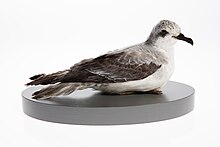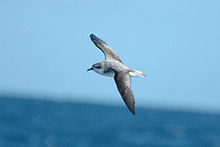Cook's petrel
| Cook's petrel | |
|---|---|

| |
| Scientific classification | |
| Domain: | Eukaryota |
| Kingdom: | Animalia |
| Phylum: | Chordata |
| Class: | Aves |
| Order: | Procellariiformes |
| Family: | Procellariidae |
| Genus: | Pterodroma |
| Species: | P. cookii
|
| Binomial name | |
| Pterodroma cookii (G.R. Gray, 1843)
| |

| |
| Synonyms | |
|
Procellaria cookii G. R. Gray, 1843 Procellaria velox G. R. Gray, 1844 (nomen novum) Pterodroma cookii orientalis Murphy, 1929 | |
Cook's petrel (Pterodroma cookii), or the tītī or blue-footed petrel,
Morphology

One of the smallest petrels, Cook's petrel is typically 25–30 cm (9.8–11.8 in) in length with a 65–66 cm (26–26 in) wingspan and a weight of around 200 g (7.1 oz). Its colouration is typical of gadfly petrels: pale grey upperparts with a dark grey "M" on the wings and white underparts.[3]
The bill is long and black with tubular nostrils on both sides. As in all members of the order Procellariiformes, this nostril configuration enables an exceptionally acute sense of smell, which the birds use to locate food and nest sites in the dark.
Diet
Cook's petrel feeds mostly on
Habitat

Cook's petrel breeds only in
Cook's petrel migrates to the Pacific Ocean from New Zealand when it is not breeding. It has sometimes been seen off the west coast of the United States and off the west coast of tropical South America.
References
- . Retrieved 13 November 2021.
- ^ "Cook's petrel | New Zealand Birds Online".
- ^ ISBN 978-0198508311.
- ^ Harrison, P.; Perrow, M.; Larsson, H. (2021). Seabirds: The New Identification Guide. Lynx Edicions, Barcelona. 1-600 (400).
- Cook's petrel media from ARKive
- Field Guide to the Birds of North America. National Geographic. 2002. ISBN 0-7922-6877-6.
- Harrison, Peter (1985). Seabirds, an Identification Guide. ISBN 0-395-60291-2.
- del Hoyo, Josep (ed.). Handbook of the Birds of the World. Vol. 1. ISBN 84-87334-10-5.
- ISBN 0-679-45122-6.
External links
- BirdLife species factsheet for Pterodroma cookii
- "Pterodroma cookii". Avibase.
- "Cook's petrel media". Internet Bird Collection.
- Cook's petrel photo gallery at VIREO (Drexel University)
- Interactive range map of Pterodroma cookii at IUCN Red List maps
- Audio recordings of Cook's petrel on Xeno-canto.

